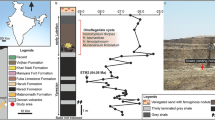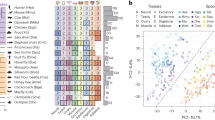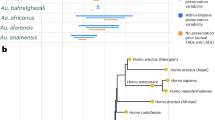Abstract
The interplay of evolution and development has been at the heart of evolutionary theory for more than a century1. Heterochrony—change in the timing or rate of developmental events—has been implicated in the evolution of major vertebrate lineages such as mammals2, including humans1. Birds are the most speciose land vertebrates, with more than 10,000 living species3 representing a bewildering array of ecologies. Their anatomy is radically different from that of other vertebrates. The unique bird skull houses two highly specialized systems: the sophisticated visual and neuromuscular coordination system4,5 allows flight coordination and exploitation of diverse visual landscapes, and the astonishing variations of the beak enable a wide range of avian lifestyles. Here we use a geometric morphometric approach integrating developmental, neontological and palaeontological data to show that the heterochronic process of paedomorphosis, by which descendants resemble the juveniles of their ancestors, is responsible for several major evolutionary transitions in the origin of birds. We analysed the variability of a series of landmarks on all known theropod dinosaur skull ontogenies as well as outgroups and birds. The first dimension of variability captured ontogeny, indicating a conserved ontogenetic trajectory. The second dimension accounted for phylogenetic change towards more bird-like dinosaurs. Basally branching eumaniraptorans and avialans clustered with embryos of other archosaurs, indicating paedomorphosis. Our results reveal at least four paedomorphic episodes in the history of birds combined with localized peramorphosis (development beyond the adult state of ancestors) in the beak. Paedomorphic enlargement of the eyes and associated brain regions parallels the enlargement of the nasal cavity and olfactory brain in mammals6. This study can be a model for investigations of heterochrony in evolutionary transitions, illuminating the origin of adaptive features and inspiring studies of developmental mechanisms.
This is a preview of subscription content, access via your institution
Access options
Subscribe to this journal
Receive 51 print issues and online access
$199.00 per year
only $3.90 per issue
Buy this article
- Purchase on Springer Link
- Instant access to full article PDF
Prices may be subject to local taxes which are calculated during checkout






Similar content being viewed by others
References
Gould, S. J. Ontogeny and Phylogeny (Belknap, 1977)
Rowe, T. Coevolution of the mammalian middle ear and neocortex. Science 273, 651–654 (1996)
Gill, F. B. Ornithology (Freeman, 2006)
Nieuwenhuys, R., Ten Donkelaar, H. J. & Nicholson, C. The Central Nervous System of Vertebrates (Springer, 1998)
Butler, A. B. & Hodos, W. Comparative Vertebrate Neuroanatomy (Wiley, 1996)
Rowe, T. B., Macrini, T. E. & Luo, Z.-X. Fossil evidence on origin of the mammalian brain. Science 332, 955–957 (2011)
Nesbitt, S. J. The early evolution of archosaurs: relationships and the origin of major clades. Bull. Am. Mus. Nat. Hist. 352, 1–292 (2011)
Erickson, G. M. et al. Was dinosaurian physiology inherited by birds? Reconciling slow growth in Archaeopteryx . PLoS ONE 4, e7390 (2009)
Wellnhofer, P. Archaeopteryx: The Icon of Evolution (Verlag Dr Friedrich Pfeil, 2009)
Jollie, M. T. The head skeleton of the chicken and remarks on the anatomy of this region in other birds. J. Morphol. 100, 389–436 (1957)
Jerison, H. J. Evolution of the Brain and Intelligence (Academic, 1973)
Pearson, R. The Avian Brain (Academic, 1972)
Thulborn, R. A. Theropod dinosaurs, progenesis and birds: homology of digits in the manus. Neues Jb. Geol. Paläontol. Abh. 242, 205–241 (2006)
Alonso, P. D., Milner, A. C., Ketcham, R. A., Cookson, M. J. & Rowe, T. B. The avian nature of the brain and inner ear of Archaeopteryx . Nature 430, 666–669 (2004)
Brusatte, S. L., Sakamoto, M., Montanari, S. & Harcourt Smith, W. E. H. The evolution of cranial form and function in theropod dinosaurs: insights from geometric morphometrics. J. Evol. Biol. 25, 365–377 (2011)
Padian, K., De Ricqlès, A. & Horner, J. R. Dinosaurian growth rates and bird origins. Nature 412, 405–408 (2001)
Alberch, P., Gould, S. J., Oster, G. F. & Wake, D. B. Size and shape in ontogeny and phylogeny. Paleobiology 5, 296–317 (1979)
Turner, A. H., Pol, D., Clarke, J. A., Erickson, G. M. & Norell, M. A. A basal dromaeosaurid and size evolution preceding avian flight. Science 317, 1378–1381 (2007)
Lu, J., Unwin, D. M., Jin, X., Liu, Y. & Ji, Q. Evidence for modular evolution in a long-tailed pterosaur with a pterodactyloid skull. Proc. R. Soc. B 277, 383–389 (2010)
Rowe, T. Definition, diagnosis, and origin of Mammalia. J. Vertebr. Paleontol. 8, 241–264 (1988)
Kielan-Jaworowska, Z., Cifelli, R. L. & Luo, Z.-X. Mammals From the Age of Dinosaurs: Origins, Evolution, and Structure (Columbia Univ. Press, 2004)
Fink, W. L. The conceptual relationship between ontogeny and phylogeny. Paleobiology 8, 254–264 (1982)
Northcutt, R. G. Evolving large and complex brains. Science 332, 926–927 (2011)
Hopson, J. A. Relative brain size and behavior in nonavian reptiles. Annu. Rev. Ecol. Syst. 8, 429–448 (1977)
Hu, D. & Marcucio, R. S. A SHH-responsive signaling center in the forebrain regulates craniofacial morphogenesis via the facial ectoderm. Development 136, 107–116 (2009)
Norell, M. A. et al. A review of the Mongolian Cretaceous dinosaur Saurornithoides (Troodontidae: Theropoda). Am. Mus. Novit. 3654, 1–63 (2009)
Clarke, J. A. & Middleton, K. M. Mosaicism, molecules, and the evolution of birds: results from a Bayesian approach to the study of morphological evolution using discrete character data. Syst. Biol. 57, 185–201 (2008)
Hunt, G. R. Manufacture and use of hook-tools by New Caledonian crows. Nature 379, 249–251 (1996)
Smith, K. K. Time’s arrow: heterochrony and the evolution of development. Int. J. Dev. Biol. 47, 613–621 (2003)
Acknowledgements
We thank R. M. Elsey and colleagues at the Rockefeller Wildlife Refuge, Louisiana Department of Wildlife and Fisheries for assistance in obtaining alligator embryos, S. Majadla for imaging assistance, C. Sánchez for constructing the Supplementary Movie, I. Sarris for assistance with the R script packages, and J. B. Losos, H. E. Hoekstra, F. A. Jenkins Jr and B. Zweig for comments that improved the manuscript. B.-A.S.B. was partly funded by National Science Foundation dissertation improvement grant 1110564. J.M.-L. was supported by project BFU2008-00642.
Author information
Authors and Affiliations
Contributions
B.-A.S.B. and A.A. designed the study. B.-A.S.B. wrote the paper and performed CT scans, data entry and analytical work. J.M.-L. performed analytical work and assisted with writing and figures. F.R. performed data entry and analytical work. G.B. helped conceive the project and performed data processing on new CT data. T.B.R. contributed CT data and assisted in data interpretation and writing the paper. M.A.N. contributed the major hypotheses to be tested, provided CT data and assisted in writing the paper. A.A. co-wrote the paper.
Corresponding authors
Ethics declarations
Competing interests
The authors declare no competing financial interests.
Supplementary information
Supplementary Information
This file contains Supplementary Data 1-13, which comprises: Supplementary Text (1-9) and (11); Supplementary Figures 1-10 (10); Supplementary Methods and Supplementary Tables 1-4 (12); and Supplementary References (13) = – see Contents for details. Page 2 contains instructions for the Supplementary Animation files (see separate zipped files). (PDF 3234 kb)
Supplementary Animation
This zipped file contains a flash animation file (.swf) and a zipped file, which contains the ‘ontology.htm’ and ‘ontology.swf’ files. Instructions on how to open these files is given on page 2 of the Supplementary Information file. (ZIP 2360 kb)
Rights and permissions
About this article
Cite this article
Bhullar, BA., Marugán-Lobón, J., Racimo, F. et al. Birds have paedomorphic dinosaur skulls. Nature 487, 223–226 (2012). https://doi.org/10.1038/nature11146
Received:
Accepted:
Published:
Issue Date:
DOI: https://doi.org/10.1038/nature11146
This article is cited by
-
Broad snouted cladoselachian with sensory specialization at the base of modern chondrichthyans
Swiss Journal of Palaeontology (2023)
-
The neck as a keystone structure in avian macroevolution and mosaicism
BMC Biology (2023)
-
Rapid and biased evolution of canalization during adaptive divergence revealed by dominance in gene expression variability during Arctic charr early development
Communications Biology (2023)
-
Ontogenetic drivers of morphological evolution in monitor lizards and allies (Squamata: Paleoanguimorpha), a clade with extreme body size disparity
BMC Ecology and Evolution (2022)
-
Body size, shape and ecology in tetrapods
Nature Communications (2022)
Comments
By submitting a comment you agree to abide by our Terms and Community Guidelines. If you find something abusive or that does not comply with our terms or guidelines please flag it as inappropriate.



